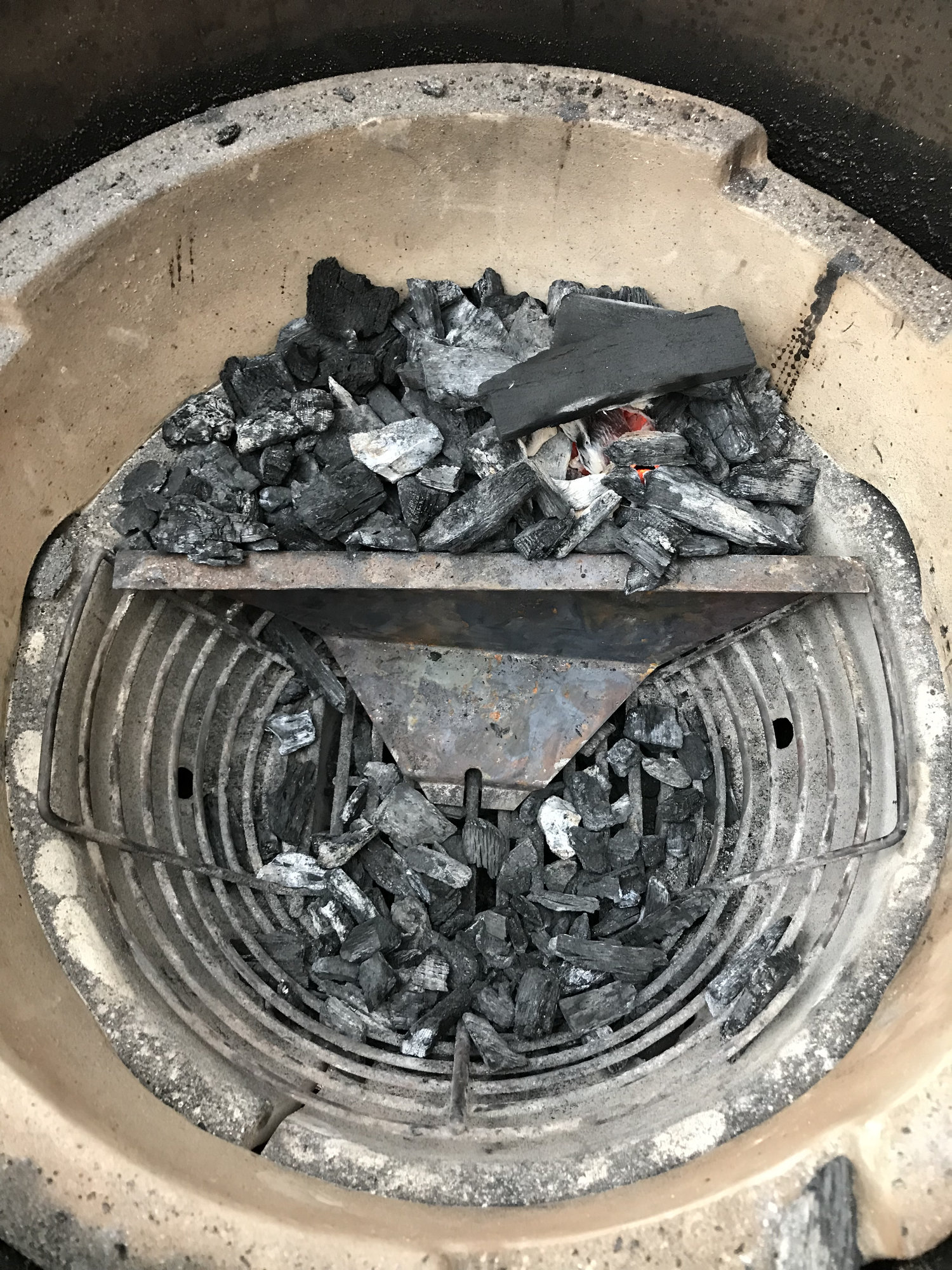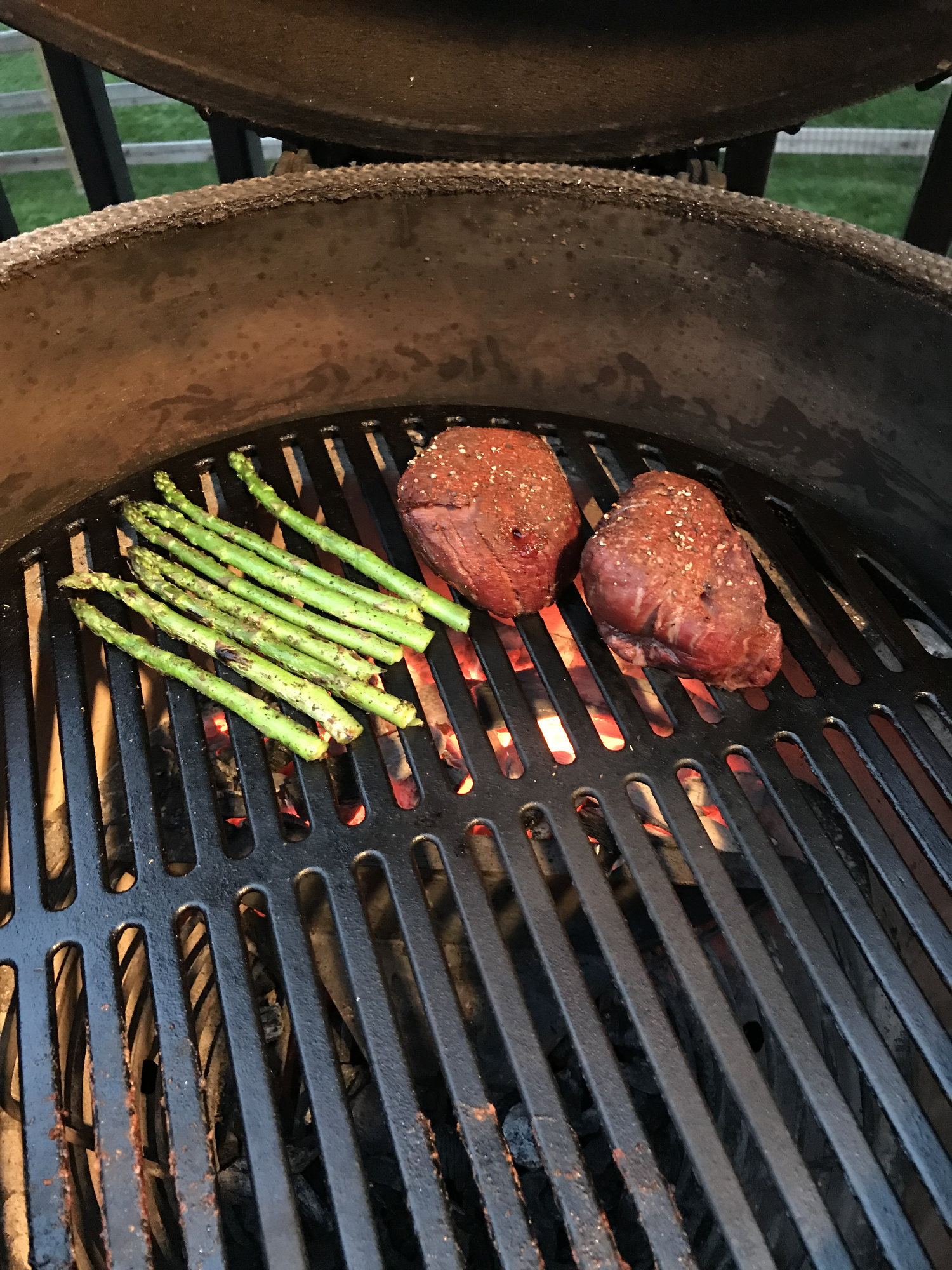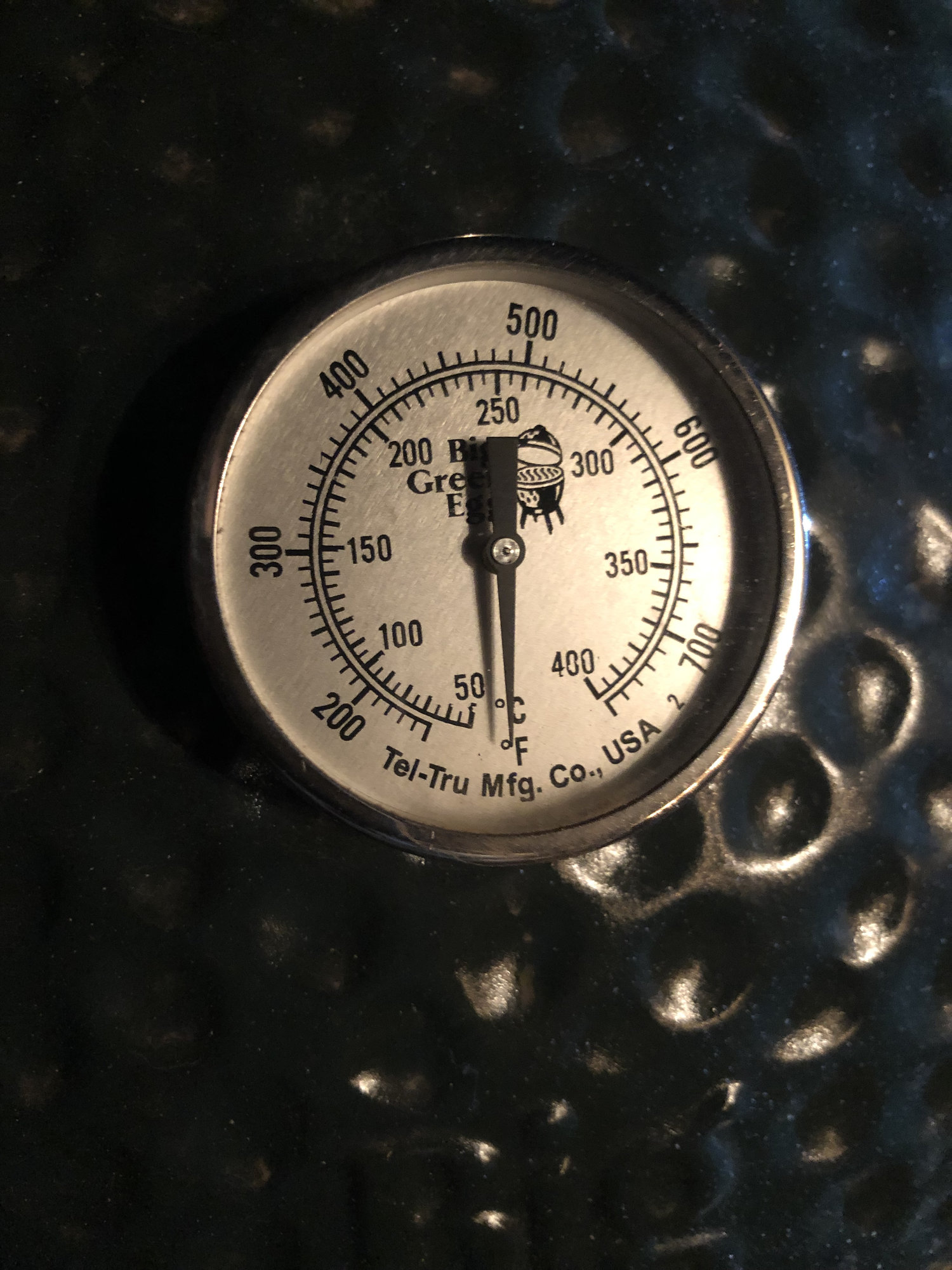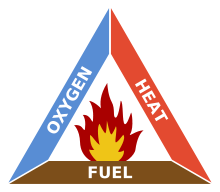Welcome to the EGGhead Forum - a great place to visit and packed with tips and EGGspert advice! You can also join the conversation and get more information and amazing kamado recipes by following Big Green Egg to Experience our World of Flavor™ at:
Want to see how the EGG is made? Click to Watch
Facebook | Twitter | Instagram | Pinterest | Youtube | Vimeo
Share your photos by tagging us and using the hashtag #BigGreenEgg.
Share your photos by tagging us and using the hashtag #BigGreenEgg.
Want to see how the EGG is made? Click to Watch
How quantity of lump affects temp...

Slippy
Posts: 214
When I first got my egg, I watched dozens of YouTube video about different cooks and for tips/tricks... This was a few years ago, but I seem to recall one guy saying that for higher temp cooks use less lump, because it allows more oxygen to the fire... Any truth to that statement? I have tried this and it never really worked for me, the fire just dies out faster..... Any other tips on how quantity of lump affects temps?
Rockwall, TX • LBGE, Big Hat Ranger offset smoker, Really old 22" Weber Kettle, Pile of Pecan and Post Oak...
Comments
-
Air flow is the primary driver of temps. You must of course have a cumustible (lump) but the amount of lump matters more for the length of the cook more so than the temp. Also how you light the fire plays a role(1 spot or multiple). I think you’ve answered your question.Sandy Springs & Dawsonville Ga
-
I have noticed that lump size affects temps greatly. A huge pile of big pieces will breathe easily and can build a monstrous flame. For low and slows, I try to add a lot of small pieces to fill the cracks that would otherwise be filled with air. I notice a big difference with this factor.
-
^^^^^^^ What these guys said^^^^^^^Chicago, IL BGE XL BGE Mini Webber Charcoal / Elmhurst, IL
-
This is true. Air flow can alter this equation between L & S or ripping hot independent of lump size. Vents wide open, unless you’re full of dust gets one a hot fire.GrateEggspectations said:I have noticed that lump size affects temps greatly. A huge pile of big pieces will breathe easily and can build a monstrous flame. For low and slows, I try to add a lot of small pieces to fill the cracks that would otherwise be filled with air. I notice a big difference with this factor.Sandy Springs & Dawsonville Ga -
The "how you light" comment is interesting. Have any tips on which ones work best in certain situations?bgebrent said:Air flow is the primary driver of temps. You must of course have a cumustible (lump) but the amount of lump matters more for the length of the cook more so than the temp. Also how you light the fire plays a role(1 spot or multiple). I think you’ve answered your question.Rockwall, TX • LBGE, Big Hat Ranger offset smoker, Really old 22" Weber Kettle, Pile of Pecan and Post Oak... -
For L & S light one spot center to front center. Let it establish then set your vents. For 350-400 cooks light 3-4 spots. How long you leave vents and lid open also affect your temps.Slippy said:
The "how you light" comment is interesting. Have any tips on which ones work best in certain situations?bgebrent said:Air flow is the primary driver of temps. You must of course have a cumustible (lump) but the amount of lump matters more for the length of the cook more so than the temp. Also how you light the fire plays a role(1 spot or multiple). I think you’ve answered your question.Sandy Springs & Dawsonville Ga -
If you light in multiple spots for a low and slow the fire is more likely to go out.
-
I will chime in and say and agree that lump size matters as well. As far as lighting the fire in relation to temp, the I use a 1600 degree weed burner to fire up—all the time. For L&S it gets a quick half throttle in the center. For steaks and pizza I give it right to her until the top is cherry red. Maybe 2-3 minutes or so. To me the way you light is not the issue, it’s how much lump you start. It takes some practice. Trust me , I had plenty of them get out of hand with this method in the beginning.Columbus, Ohio--A Gasser filled with Matchlight and an Ugly Drum.
-
I remember one guy saying he sorted his lump by size, I thought he was a nutjob... now i realize he was on to something, you never stop learning here....Chicago, IL BGE XL BGE Mini Webber Charcoal / Elmhurst, IL
-
It comes down to carbonization more than size of the lump. You'll get bigger flames off lower carbonized wood because of the volatiles, but once they're gone and the carbon lights off and that burns hotter than anything else. Carbon is extremely porous, so the oxygen gets in everywhere and it burns inside and out.
-
-
To a point, I exclusively use your charcoal and (as with any natural lump) the fines in the bottom of the bag will clog the air holes in the bottom of the charcoal grate... sure more carbonized charcoal is better but if the airflow is blocked than no air equals no combustion. I'm starting to think sorting lump is the way to go, kind of like kindling to start a fire with big logs...stlcharcoal said:It comes down to carbonization more than size of the lump. You'll get bigger flames off lower carbonized wood because of the volatiles, but once they're gone and the carbon lights off and that burns hotter than anything else. Carbon is extremely porous, so the oxygen gets in everywhere and it burns inside and out.Chicago, IL BGE XL BGE Mini Webber Charcoal / Elmhurst, IL -
I don't think the smaller quantities for more oxygen = higher temp cooks holds up. Yes, high airflow is best, which is why forges have forced air systems. But there are 3 other factors for a high temp cook.First is the quality of the lump. Lump w. higher carbon content will produce more heat. It is typically harder to ignite, but once it gets going, a given airflow will produce more heat. I bought some compressed coconut shell lump a few years ago. It was high enough in carbon content that it was silvery, and clinked. Took twice as long to start using propane as average lump. But once kindled, the same vent settings as I usually use for 250 dome would produce at least 300, sometimes more.Most of the heat the food gets is from the IR the lump produces, not the hot gases. The power from that drops off by the inverse square. So the heat the food gets is very dependent on the distance from the lump surface.A subsidiary consideration is the area of the fire. Unless the inside of a cooking vessel is reflecting IR, (HD foil, anyone?) the heat the food gets is greatest from what is burning directly under it.
-
Kick Ash Basket or another replacement fire grate is the best way to fix that with any brand. We used to manufacture a replacement fire grate.....sold thousands of them. The kamado have the funnel shaped firebox ending up on a flat plate is not a very good setup for getting ash into the pan. Ash doesn't flow and there's nothing to agitate it. Unless it's above the hole, there is a good chance it's not going through. Some sort of wire grate or basically that doesn't have any flatness to it, directs the ash past the barrier and let's gravity do the work and fall into the ash pan. Of course, higher the carbonization less ash.BGEChicago said:
To a point, I exclusively use your charcoal and (as with any natural lump) the fines in the bottom of the bag will clog the air holes in the bottom of the charcoal grate... sure more carbonized charcoal is better but if the airflow is blocked than no air equals no combustion. I'm starting to think sorting lump is the way to go, kind of like kindling to start a fire with big logs...stlcharcoal said:It comes down to carbonization more than size of the lump. You'll get bigger flames off lower carbonized wood because of the volatiles, but once they're gone and the carbon lights off and that burns hotter than anything else. Carbon is extremely porous, so the oxygen gets in everywhere and it burns inside and out.
To your point about the airflow, works the other way too....more open grate, more holes or surface area for the air to flow through.
Don't sort lump, get a kick ash basket and just dump the bag in. When you start getting to the fines at the bottom of bag, switch over to a new bag to fill up to the fire ring. Then use the fines to top dress it around the outer edge. I use the whole bag everytime......and I'm not taking home good bags either. I get the ones that fall off, get run over by a forklift, or just don't look right. -
I have one of those and it did make a difference.We used to manufacture a replacement fire grate.....sold thousands of them.
bgebrent said:
Any reason to ever use a chimney to start a fire in the BGE?For L & S light one spot center to front center. Let it establish then set your vents. For 350-400 cooks light 3-4 spots. How long you leave vents and lid open also affect your temps.
Rockwall, TX • LBGE, Big Hat Ranger offset smoker, Really old 22" Weber Kettle, Pile of Pecan and Post Oak... -
In addition to what was said above about putting the small pieces of lump on top, I make sure to watch the volume of lump. If I'm doing a reverse sear, I can get by with using the divider in the KAB with not much lump. Keeps the temperature low for the beginning, then set the vent wide open and dome open. I only need high temps for a bit, and keeps me from burning a lot of lump.
However, if I'm doing a pizza, I fill to at least the top of the fire box, if not the fire ring. I need more lump to keep the temps up longer (450* for a 12 minute cook).

Cincinnati, OH
Large BGE -
That was fun..... Cooking pizza tonight, so I went quite heavy with FOGO Super Premium... Lit in four places with some fire starters. Went back inside to get the pizza prepped. Went back out about 20 minutes later and the temp was only at 300...I could tell by looking at the fire that it was way more than that... Broken dial? Nope. needle looped back around to 300... Not sure how accurate it is at that point but that was probably in the 1200°range... Yikes.. I got it under control with some air flow adjustments, but WOW... No damage done...Rockwall, TX • LBGE, Big Hat Ranger offset smoker, Really old 22" Weber Kettle, Pile of Pecan and Post Oak...
-
Reverse searing... I'm sure there are dozens of threads on this, but do you remove the meat while you get the temp up? Or just leave it on?jetman96 said:In addition to what was said above about putting the small pieces of lump on top, I make sure to watch the volume of lump. If I'm doing a reverse sear, I can get by with using the divider in the KAB with not much lump. Keeps the temperature low for the beginning, then set the vent wide open and dome open. I only need high temps for a bit, and keeps me from burning a lot of lump.
However, if I'm doing a pizza, I fill to at least the top of the fire box, if not the fire ring. I need more lump to keep the temps up longer (450* for a 12 minute cook).
 Rockwall, TX • LBGE, Big Hat Ranger offset smoker, Really old 22" Weber Kettle, Pile of Pecan and Post Oak...
Rockwall, TX • LBGE, Big Hat Ranger offset smoker, Really old 22" Weber Kettle, Pile of Pecan and Post Oak... -
remove
Southeast Florida - LBGE
In cooking, often we implement steps for which we have no explanations other than ‘that’s what everybody else does’ or ‘that’s what I have been told.’ Dare to think for yourself. -
This is around 900 or so? This is down 300 from where it was. Glad nothing cracked.


Rockwall, TX • LBGE, Big Hat Ranger offset smoker, Really old 22" Weber Kettle, Pile of Pecan and Post Oak... -
Mixing top of the new bag with the bottom of an old bag... should of thought of that before.... Thanks for the tip!stlcharcoal said:
Kick Ash Basket or another replacement fire grate is the best way to fix that with any brand. We used to manufacture a replacement fire grate.....sold thousands of them. The kamado have the funnel shaped firebox ending up on a flat plate is not a very good setup for getting ash into the pan. Ash doesn't flow and there's nothing to agitate it. Unless it's above the hole, there is a good chance it's not going through. Some sort of wire grate or basically that doesn't have any flatness to it, directs the ash past the barrier and let's gravity do the work and fall into the ash pan. Of course, higher the carbonization less ash.BGEChicago said:
To a point, I exclusively use your charcoal and (as with any natural lump) the fines in the bottom of the bag will clog the air holes in the bottom of the charcoal grate... sure more carbonized charcoal is better but if the airflow is blocked than no air equals no combustion. I'm starting to think sorting lump is the way to go, kind of like kindling to start a fire with big logs...stlcharcoal said:It comes down to carbonization more than size of the lump. You'll get bigger flames off lower carbonized wood because of the volatiles, but once they're gone and the carbon lights off and that burns hotter than anything else. Carbon is extremely porous, so the oxygen gets in everywhere and it burns inside and out.
To your point about the airflow, works the other way too....more open grate, more holes or surface area for the air to flow through.
Don't sort lump, get a kick ash basket and just dump the bag in. When you start getting to the fines at the bottom of bag, switch over to a new bag to fill up to the fire ring. Then use the fines to top dress it around the outer edge. I use the whole bag everytime......and I'm not taking home good bags either. I get the ones that fall off, get run over by a forklift, or just don't look right.Chicago, IL BGE XL BGE Mini Webber Charcoal / Elmhurst, IL -
I know a few things about thermodynamics.....especially when it comes to charcoal.BGEChicago said:
Mixing top of the new bag with the bottom of an old bag... should of thought of that before.... Thanks for the tip!stlcharcoal said:
Kick Ash Basket or another replacement fire grate is the best way to fix that with any brand. We used to manufacture a replacement fire grate.....sold thousands of them. The kamado have the funnel shaped firebox ending up on a flat plate is not a very good setup for getting ash into the pan. Ash doesn't flow and there's nothing to agitate it. Unless it's above the hole, there is a good chance it's not going through. Some sort of wire grate or basically that doesn't have any flatness to it, directs the ash past the barrier and let's gravity do the work and fall into the ash pan. Of course, higher the carbonization less ash.BGEChicago said:
To a point, I exclusively use your charcoal and (as with any natural lump) the fines in the bottom of the bag will clog the air holes in the bottom of the charcoal grate... sure more carbonized charcoal is better but if the airflow is blocked than no air equals no combustion. I'm starting to think sorting lump is the way to go, kind of like kindling to start a fire with big logs...stlcharcoal said:It comes down to carbonization more than size of the lump. You'll get bigger flames off lower carbonized wood because of the volatiles, but once they're gone and the carbon lights off and that burns hotter than anything else. Carbon is extremely porous, so the oxygen gets in everywhere and it burns inside and out.
To your point about the airflow, works the other way too....more open grate, more holes or surface area for the air to flow through.
Don't sort lump, get a kick ash basket and just dump the bag in. When you start getting to the fines at the bottom of bag, switch over to a new bag to fill up to the fire ring. Then use the fines to top dress it around the outer edge. I use the whole bag everytime......and I'm not taking home good bags either. I get the ones that fall off, get run over by a forklift, or just don't look right.
Trust me, when you get that basket or another grate in there, you'll see the size thing really doesn't matter on highly carbonized lump. It's the surface area you cannot see that is fueling the fire--and that's surface that air cannot get to if the lump is not properly carbonized (it's still wood, thus full of tars/liquors.) Air doesn't need those big gaps around the lump when it's basically getting sucked into the lump like a sponge.
Ours on average is 250 m2/g (a piece the size about the size of a golf ball has the surface area of a tennis court.) If it's not 80%+ carbon, that accessible surface area is drastically lower because of all the pours being plugged up. That's why it takes so long to light, and there's so much white smoke.
-
Interesting thread. I have a large that I can get to whatever temp I want. A couple months ago I added a MM. Only used it a half dozen times but sometimes hard to get temp up (even 300-400 range). I usually end up pulling the daisy wheel to help it along. I have been thinking could it be I put too much lump in?Central Florida
-
Don't use a cheap IR gun."Knowledge is Good" - Emil Faber
XL and MM
Louisville, Kentucky
Categories
- All Categories
- 184K EggHead Forum
- 16.1K Forum List
- 461 EGGtoberfest
- 1.9K Forum Feedback
- 10.5K Off Topic
- 2.4K EGG Table Forum
- 1 Rules & Disclaimer
- 9.2K Cookbook
- 15 Valentines Day
- 118 Holiday Recipes
- 348 Appetizers
- 521 Baking
- 2.5K Beef
- 90 Desserts
- 167 Lamb
- 2.4K Pork
- 1.5K Poultry
- 33 Salads and Dressings
- 322 Sauces, Rubs, Marinades
- 548 Seafood
- 175 Sides
- 122 Soups, Stews, Chilis
- 41 Vegetarian
- 103 Vegetables
- 315 Health
- 293 Weight Loss Forum











